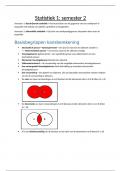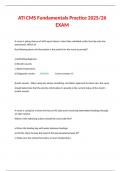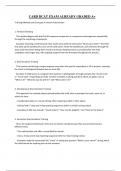Legal Drafting – Course Summary:
UNIT 1: LEGAL DRAFTING PRINCIPLES
Legal Drafting:
“Drafting”: task of creating a legal document. Can include preparing such doc from scratch, following a
template or precedent, or completing a form.
Four-stage process:
1. Preparation and research: take full instructions, undertake any further enquiries which are needed,
identify the objective(s)/purposes of the legal document, research the law.
2. Planning: decide on the best structure and necessary content.
3. Drafting: clearly and concisely set out the information/points following your plan.
4. Checking: cross-check doc to ensure it is correct, unambiguous and meets the objectives.
Preparation and research:
Taking instructions:
o Clear understanding of what client wishes to achieve and all relevant facts.
o Identify all you need to know at initial stage. This includes identifying potential pitfalls for
the client (ie what happens if obligation not fulfilled) and addressing them
Example: Your client instructs you to impose an obligation on a buyer of part of his land to put
up a 2.5 metre fence along what will become the common boundary. You must identify the need
for further information as to:
o What type of fence is required
o The time limit to be imposed
o Who will be required to maintain the fence; and
o Who will obtain planning permission and what happens if permission is not granted
Researching the law:
o Check the client is permitted by law to do the thing which is the subject of the agreement. Ie.
Can you draft a contract excluding liability for personal injury and death resulting from
negligence in the event of an accident? No.
Planning:
In some cases, the structure of a doc will be dictated for you. Ie particulars of claim, will…
You may also be asked to draft a legal doc to cover a unique situation, you will need to have a structure in
mind so that you do not omit any important protections for your client.
Common document structure:
Commencemen A legal document will normally begin with a commencement which describes the nature
t of the document, e.g. ‘This Agreement’, ‘This Conveyance’.
Alternatively, the document’s title can simply be set out as a heading.
Deeds may also use the word ‘deed’ in the title, for example ‘This deed of conveyance’.
Date A space should be left for insertion of the date when the document is completed.
Parties The full names and addresses of the parties should be inserted. (In the case of a
company, the address of its registered office should be inserted.)
1
, Example:
NB. A long and complicated legal document can benefit from an index or table of
clauses (preferably at the front).
Recitals Recitals clauses (‘Whereas ...’) are not essential and you should consider carefully
whether or not to include them.
You can use them to set out the background facts leading up to the creation of the
document and so make it more self-explanatory.
For example, in a conveyance of land by a personal representative, the date of the
deceased’s death and the date on which a grant of representation was obtained could be
recited.
Also sometimes used to introduce and summarise the contents of the operative part of
the document - BUT generally not necessary and may be confusing.
Operative part Section which creates the legal rights and obligations.
Contents will depend on the nature of the document.
E.g., commercial agreements generally contain:
(a) conditions precedent (must be satisfied before agreement in force)
(b) agreements (rights and obligations of the parties)
(c) Representations and warranties (i.e. statements about factual and legal matters which
one of the parties requires to be made to them in a legally binding way)
(d) ‘boiler-plate’ clauses (i.e. standard clauses inserted into all agreements of such a type
and dealing with, ie. Service of notices under the agreement, or jurisdiction for action)
Testimonium A testimonium clause is not essential but, if used, it introduces the signatures of the
parties and may describe a particular method of executing where, for example, a
company is using its seal as part of its execution.
Schedules Used to avoid breaking the continuity of a document with too much detail.
The operative part refers to the schedule, and the schedule contains the detail.
E.g. Tenant’s Covenants
“The Tenant covenants with the Landlord to observe and perform the covenants
set out in Schedule 1.”
Schedule 1 —> ”1. To pay the rent ... etc.”
NB. obligation or right is created in the operative part of the document.
Execution and A legal document will end with an execution clause: refers to signatures of the parties
attestation and any other formalities necessary to give the document legal effect.
Wordings depends on nature of executing party, wether doc is a deed, and whether
signature is witnessed (attested)
—> Doc executed by individual - NOT deed:
—> Doc executed as DEED:
Order of clauses in operative part:
2
, Chronological List topics in chronological order - suitable for a legal document that deals with one
order simple transaction. E.g. Contract for the hire of a car:
Parties
Definitions
Agreement by Owner to hire out car to Hirer on the terms set out in the agreement
Payment
Insurance
Promises by Owner as to the state of the car at the start of the hire
Duration of hire
What the car can be used for
Who may drive
Hirer’s promises as to return of the car
Remedies for breach of the agreement
For such type of contract, a chronological structure will produce a simpler and less
repetitious document
Categorical Sets out the duties and responsibilities in categories. E.g. a lease:
order Parties
Definitions
The grant of the term by the Landlord to the Tenant
Tenant’s covenants
Landlord’s covenants
provisos, e.g. the Landlord’s power to forfeit the lease.
Here, the division into landlord’s obligations and tenant’s obligations is essential.
The obligations must be performed throughout the entire term of the lease. There is no
chronological order to them.
Order of Can be used for a simple contract, where the obligations are not to be carried out in any
importance chronological order.
E.g. agreement btw employer and employee on severance of employment
Combinations Doc may use a combination of the above structures.
E.g. contract with a firm of furniture removers could list the firm’s obligations in
chronological order
To pack the contents of the house
To transport storage
To store
To transport to new house
To unpack
And then list the owner’s obligations.
NB. In a lease, a combination of structure is used: all the tenant’s covenants will be put
together but will appear in order of importance.
Structuring a clause:
When you are structuring clauses and sub-clauses within the operative part:
use a separate clause for each separate matter
use sub-paragraphs to avoid long, cumbersome clauses and provisos
number each clause and sub-clause
give each clause or group of clauses a heading that correctly defines the subject matter of the
clauses, e.g. ‘Tenant’s Covenants’.
Example 1: The Licensee shall purchase exclusively from the Grantor all materials used in making the
Invention provided that the licensee shall be entitled to relieve itself of its liability to observe this
obligation upon giving the Grantor three months’ notice in writing.
Example 2:
3
, 1. Subject to Clause 2, the Licensee must purchase exclusively from the Grantor all materials used in
making the Invention.
2. The Licensee may end the obligation contained in Clause 1 by giving the Grantor three months’
notice in writing.
Structuring a clause according to Coode:
Georg Coode’s general principle is that a clause should be structured in the following order:
circumstances/exceptions (i.e. circumstances where the right or obligation does or does not exist);
o Words suitable for introducing circumstances: ‘where…’ ‘if…then’ ‘when…’ or ‘on…’
o Words suitable for introducing an exception: ‘except where ...’ ‘save where ...’
conditions (i.e. conditions on which the right or obligation depends);
o Words suitable for introductions conditions: ‘if…’ ‘provided that…’
obligation or right (i.e. who must do what or who may do what).
The Coode rule does not have to be followed invariably:
Form:
Rather than creating a legal document, the drafting which you carry out in legal practice or in the SQE2
assessments may require you to complete a form, such as a TR1 which is the HM Land Registry form used to
transfer the whole of a property where the title is registered.
Although to a certain extent the form will provide the structure for the drafting you will still need to
construct your response to the individual sections carefully, following the guidance on the form.
4
UNIT 1: LEGAL DRAFTING PRINCIPLES
Legal Drafting:
“Drafting”: task of creating a legal document. Can include preparing such doc from scratch, following a
template or precedent, or completing a form.
Four-stage process:
1. Preparation and research: take full instructions, undertake any further enquiries which are needed,
identify the objective(s)/purposes of the legal document, research the law.
2. Planning: decide on the best structure and necessary content.
3. Drafting: clearly and concisely set out the information/points following your plan.
4. Checking: cross-check doc to ensure it is correct, unambiguous and meets the objectives.
Preparation and research:
Taking instructions:
o Clear understanding of what client wishes to achieve and all relevant facts.
o Identify all you need to know at initial stage. This includes identifying potential pitfalls for
the client (ie what happens if obligation not fulfilled) and addressing them
Example: Your client instructs you to impose an obligation on a buyer of part of his land to put
up a 2.5 metre fence along what will become the common boundary. You must identify the need
for further information as to:
o What type of fence is required
o The time limit to be imposed
o Who will be required to maintain the fence; and
o Who will obtain planning permission and what happens if permission is not granted
Researching the law:
o Check the client is permitted by law to do the thing which is the subject of the agreement. Ie.
Can you draft a contract excluding liability for personal injury and death resulting from
negligence in the event of an accident? No.
Planning:
In some cases, the structure of a doc will be dictated for you. Ie particulars of claim, will…
You may also be asked to draft a legal doc to cover a unique situation, you will need to have a structure in
mind so that you do not omit any important protections for your client.
Common document structure:
Commencemen A legal document will normally begin with a commencement which describes the nature
t of the document, e.g. ‘This Agreement’, ‘This Conveyance’.
Alternatively, the document’s title can simply be set out as a heading.
Deeds may also use the word ‘deed’ in the title, for example ‘This deed of conveyance’.
Date A space should be left for insertion of the date when the document is completed.
Parties The full names and addresses of the parties should be inserted. (In the case of a
company, the address of its registered office should be inserted.)
1
, Example:
NB. A long and complicated legal document can benefit from an index or table of
clauses (preferably at the front).
Recitals Recitals clauses (‘Whereas ...’) are not essential and you should consider carefully
whether or not to include them.
You can use them to set out the background facts leading up to the creation of the
document and so make it more self-explanatory.
For example, in a conveyance of land by a personal representative, the date of the
deceased’s death and the date on which a grant of representation was obtained could be
recited.
Also sometimes used to introduce and summarise the contents of the operative part of
the document - BUT generally not necessary and may be confusing.
Operative part Section which creates the legal rights and obligations.
Contents will depend on the nature of the document.
E.g., commercial agreements generally contain:
(a) conditions precedent (must be satisfied before agreement in force)
(b) agreements (rights and obligations of the parties)
(c) Representations and warranties (i.e. statements about factual and legal matters which
one of the parties requires to be made to them in a legally binding way)
(d) ‘boiler-plate’ clauses (i.e. standard clauses inserted into all agreements of such a type
and dealing with, ie. Service of notices under the agreement, or jurisdiction for action)
Testimonium A testimonium clause is not essential but, if used, it introduces the signatures of the
parties and may describe a particular method of executing where, for example, a
company is using its seal as part of its execution.
Schedules Used to avoid breaking the continuity of a document with too much detail.
The operative part refers to the schedule, and the schedule contains the detail.
E.g. Tenant’s Covenants
“The Tenant covenants with the Landlord to observe and perform the covenants
set out in Schedule 1.”
Schedule 1 —> ”1. To pay the rent ... etc.”
NB. obligation or right is created in the operative part of the document.
Execution and A legal document will end with an execution clause: refers to signatures of the parties
attestation and any other formalities necessary to give the document legal effect.
Wordings depends on nature of executing party, wether doc is a deed, and whether
signature is witnessed (attested)
—> Doc executed by individual - NOT deed:
—> Doc executed as DEED:
Order of clauses in operative part:
2
, Chronological List topics in chronological order - suitable for a legal document that deals with one
order simple transaction. E.g. Contract for the hire of a car:
Parties
Definitions
Agreement by Owner to hire out car to Hirer on the terms set out in the agreement
Payment
Insurance
Promises by Owner as to the state of the car at the start of the hire
Duration of hire
What the car can be used for
Who may drive
Hirer’s promises as to return of the car
Remedies for breach of the agreement
For such type of contract, a chronological structure will produce a simpler and less
repetitious document
Categorical Sets out the duties and responsibilities in categories. E.g. a lease:
order Parties
Definitions
The grant of the term by the Landlord to the Tenant
Tenant’s covenants
Landlord’s covenants
provisos, e.g. the Landlord’s power to forfeit the lease.
Here, the division into landlord’s obligations and tenant’s obligations is essential.
The obligations must be performed throughout the entire term of the lease. There is no
chronological order to them.
Order of Can be used for a simple contract, where the obligations are not to be carried out in any
importance chronological order.
E.g. agreement btw employer and employee on severance of employment
Combinations Doc may use a combination of the above structures.
E.g. contract with a firm of furniture removers could list the firm’s obligations in
chronological order
To pack the contents of the house
To transport storage
To store
To transport to new house
To unpack
And then list the owner’s obligations.
NB. In a lease, a combination of structure is used: all the tenant’s covenants will be put
together but will appear in order of importance.
Structuring a clause:
When you are structuring clauses and sub-clauses within the operative part:
use a separate clause for each separate matter
use sub-paragraphs to avoid long, cumbersome clauses and provisos
number each clause and sub-clause
give each clause or group of clauses a heading that correctly defines the subject matter of the
clauses, e.g. ‘Tenant’s Covenants’.
Example 1: The Licensee shall purchase exclusively from the Grantor all materials used in making the
Invention provided that the licensee shall be entitled to relieve itself of its liability to observe this
obligation upon giving the Grantor three months’ notice in writing.
Example 2:
3
, 1. Subject to Clause 2, the Licensee must purchase exclusively from the Grantor all materials used in
making the Invention.
2. The Licensee may end the obligation contained in Clause 1 by giving the Grantor three months’
notice in writing.
Structuring a clause according to Coode:
Georg Coode’s general principle is that a clause should be structured in the following order:
circumstances/exceptions (i.e. circumstances where the right or obligation does or does not exist);
o Words suitable for introducing circumstances: ‘where…’ ‘if…then’ ‘when…’ or ‘on…’
o Words suitable for introducing an exception: ‘except where ...’ ‘save where ...’
conditions (i.e. conditions on which the right or obligation depends);
o Words suitable for introductions conditions: ‘if…’ ‘provided that…’
obligation or right (i.e. who must do what or who may do what).
The Coode rule does not have to be followed invariably:
Form:
Rather than creating a legal document, the drafting which you carry out in legal practice or in the SQE2
assessments may require you to complete a form, such as a TR1 which is the HM Land Registry form used to
transfer the whole of a property where the title is registered.
Although to a certain extent the form will provide the structure for the drafting you will still need to
construct your response to the individual sections carefully, following the guidance on the form.
4










